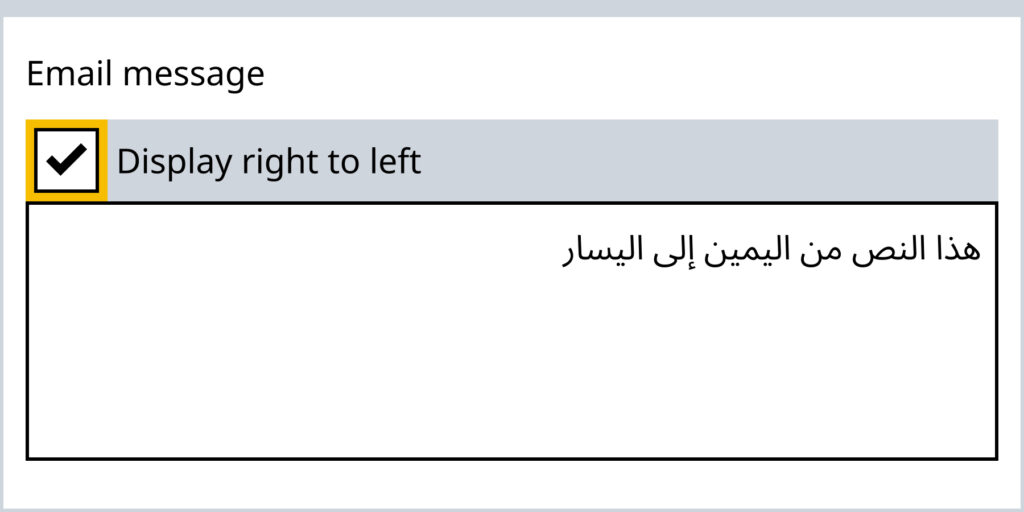Use this guide to write email message templates. To check formatting, send yourself a message before sending to recipients.
You can also send messages with custom content.
Titles
To add a title to your message, use the number sign (#) followed by a space. To add a subtitle, use two number signs (##) followed by a space. For example:
# This is an example of a title
## This is an example of a subtitle
This is plain paragraph textThis is an example of a title
This is an example of a subtitle
This is plain paragraph text
Bold and italic
To add bold, use two asterisks (**) on each side of your text. To add italic, use underscores (_) on each side of your text. For example:
This is a paragraph with **bold** and _italic_.This is a paragraph with bold and italic.
Sections
To separate the message into sections, use three underscores (_ _ _) to create a horizontal line. For example:
Section 1 --- Section 2
Section 1
Section 2
Bulleted lists
To add bullet points, use asterisks (*) followed by a space. Bullet points help recipients identify important information quickly. For example:
* point 1
* point 2
* point 3- point 1
- point 2
- point 3
Numbered lists
In front of each item in a list, insert the number followed by a period and a space. If you want GC Notify to number the list for you, insert the number 1 in front of each item.
If you start a new list later in your template, insert 1 in front of each item again.
1. Item
1. Item
1. Item
This is an example of a new list later in the template:
1. Item
1. Item
1. Item- Item
- Item
- Item
This is an example of a new list later in the template:
- Item
- Item
- Item
Multi-level numbered lists
GC Notify supports nested lists. To provide accessible content, we recommend limiting nests to 2 or 3 levels. Instead, use headings to break content into sections.
To nest a list, insert three spaces in front of each list item. For example, insert three spaces to create a second level list, and six spaces to create a third level list.
1. First level
1. First level
1. Second level
1. Second level
1. Second level
1. Third level
1. Third level
- First level
- First level
- Second level
- Second level
- Second level
- Third level
- Third level
Block format
To add a vertical grey bar to the side of text, use a caret (^) followed by a space in front of the text. For example:
^TextText
Links
To include a link, add the full URL (starting with https://) and it will become an interactive hyperlink. For example:
Apply now at https://www.canada.caApply now at https://www.canada.ca
To embed a link in your message, use square brackets around descriptive text, followed by round brackets around the URL. Make sure links make sense out of context (avoid “click here”). For example:
[Sign in](https://www.canada.ca/sign-in)You can embed a link to an email address. Then recipients can access the link through descriptive text, such as “Email us.” If recipients select the text, their inbox opens and shows a new message addressed to that email address. They compose and send the message.
Put square brackets around the descriptive text. Then enter an open bracket followed by the label “mailto:,” followed by the email address and a closed bracket. For example:
[Email us](mailto:address@department.gc.ca)To include a personalised link in your message, use double round brackets around the personalised link, as you would for a variable. To embed a personalised link, use square brackets around the descriptive text, followed by triple round brackets around the variable link.
Apply now at ((link))
[Your personalised link](((link)))Apply now at https://www.canada.ca
Language attribute tags
Language tags help make bilingual emails more accessible by indicating how content should be read by a screenreader. Use [[en]] on the line before English text and [[/en]] on the line following English text. Use [[fr]] on the line before French text and [[/fr]] after on the line following French text.
[[en]]
# Example of an English title
English text
[[/en]][[fr]]
# Exemple de titre en français
Texte en français
[[/fr]]
Example of an English title
English text
Exemple de titre en français
Texte en français
Languages read from right to left
You can create one part of your template or the entire template in right-to-left text.
To create an entire template in right-to-left text, mark the checkbox labeled “Display right to left.” The checkbox is located above the section where you enter the email message.

For templates with both left-to right and right-to-left text, use tags. Enter [[rtl]] before the right-to-left text and [[/rtl]] following the right-to-left text.
[[rtl]]
هذا النص من اليمين إلى اليسار
[[/rtl]]
هذا النص من اليمين إلى اليسار
